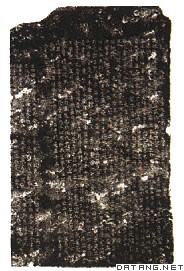2) Khitan Small Script


契丹小字
1.
A Research on Pronunciations of Some Common Original Characters of Khitan Small Script;


契丹小字几个常用原字读音研究
2.
It has been known that the first three Khitan small scripts of "Lang Jun Xing Ji" refers to "Da Jin Guo".
契丹小字《郎君行记》的首三字表示"大金国"。
3.
Tyoudagoro interpreted the Khitan small script (?) which means "east"in the 1990s.


上世纪90年代日本学者丰田五郎先生释读了表示“东”的契丹小字划大化。
3) The National Records of Khitan


《契丹国志》
1.
The Compiling Features and Historiography Value of The National Records of Khitan


《契丹国志》的编纂特色与史学价值
4) Qidanzi


契丹字
5) Epitaph
[英]['epɪtɑ:f] [美]['ɛpə'tæf]


墓志
1.
New idea on the origin of Chinese ancient epitaph —— making commentary on different opinions of the predecessors simultaneously;
中国古代墓志起源新论——兼评诸种旧说
2.
Epitaph:the Widows Life of Tang Dynasty;


唐代寡居女性生活探微——以墓志为基础
3.
My View on the Epitaph of Ino Manari, a Japanese Student Studying in the Tang Dynasty, China;
关于唐日本留学生井真成墓志之我见
6) epigraph
[英]['epɪɡrɑ:f] [美]['ɛpə'græf]


墓志
1.
The epigraphs about Cui Shi unearthed in Changzhi area is chosely related to Cui Shi in Qinghe in the Northern Wei Dynasty.
长治地区出土的关于崔氏的墓志与北魏时期清河崔氏有密切的关联,清河崔氏在西晋末年十六国时期移居长治地区,入隋唐以后仍留居此地。
2.
The prince of Langling s epigraph has its special value to testify,correct and add up to the historical facts.
朗陵王墓志铭具有证史、纠史、补史的价值。
3.
The epigraphs in the Tang Dynasty possess very important historical value in studying politics, economy, culture, military affairs and so on in the Tang Dynasty.
唐代墓志对于研究唐代政治、经济、文化、军事等有非常重要的史料价值。
补充资料:契丹文
| 契丹文 中国辽代为记录契丹语而参照汉字创制的文字。分大字和小字两种。相传大字是辽太祖耶律阿保机于神册五年(920)在突吕不、鲁不古等人赞助下创制,小字是太祖弟耶律迭剌所创制,制字年代略晚于大字。金灭辽后契丹文继续使用,并在女真制字的过程中起过很大作用。金章宗明昌二年(1191)“诏罢契丹字”,契丹文乃渐失传。契丹文图书全部湮灭,除《燕北录》和《书史会要》里收录的几个契丹字外未留下片纸只字。从出土的契丹文哀册和碑刻来看,大字是一种表意方块字,其中夹杂一些直接借用汉字的形式。小字是一种拼音文字,利用汉字笔画形体创制出 300多个原字,然后缀合拼写成词。原字分正楷、行草、篆书等字体,篆体字的拼写方式异于正楷和行草,采取鱼贯式 而不是层叠式。行文的款式自上而下竖写,自右而左换行,敬词抬头或空格。原字有一个书写形式,代表几种语音或一个语音采用几种书写形式的情况。因此,同一个词或词素表现在文字上可以有不同的拼写形式。
|
说明:补充资料仅用于学习参考,请勿用于其它任何用途。
参考词条
